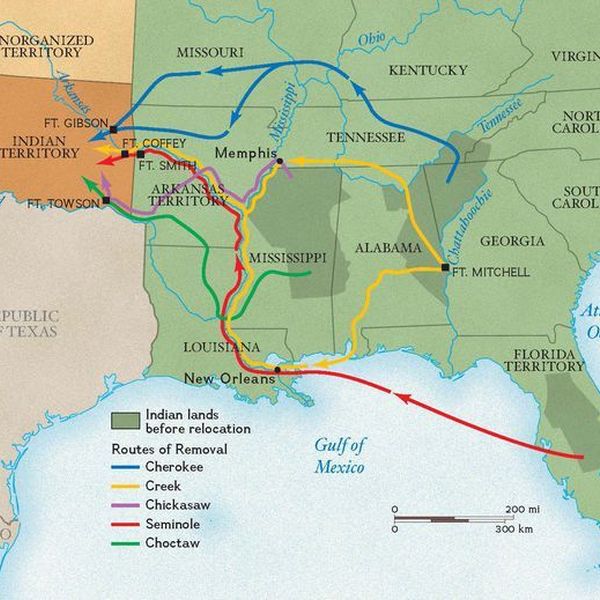Indian Removal Act History and Effect
A bill named the Indian Removal Act was passed in 1830. This bill authorized the President to grant unsettled lands in the west for exchange in for land in the east, but the natives weren’t allowed to choose if they wanted to get land in the west because the government essentially forced natives in the east coast to be moved all the way to the west. I believe that forcing a group of people who have lived in an area for decades without their consent was not a very prime decision of them. May 28, 1830 something was brewing up in Washington DC, that something was a new bill.
This new bill was dubbed the Indian Removal Act, while it might have had good intentions at first the bill ended up making some native’s lives a living hell. What this Act did was it Authorized the President to grand unsettled land in the west in exchange for their territory in the east. Sounds good, doesn’t it? Well, there is a catch, according to www.britannica.com ‘s article on the Indian Removal act most of the natives didn’t have a say in whether they wanted to move to the west or not, some of the northern tribes resettled peacefully, but in the south things were different. Members of the 5 Civilized tribes refused to leave, but it’s not like they had a choice, around 100,000 tribesmen were forced to the west with U.S army supervision around a quarter of the 100,000 were Cherokees.
The Trail of Tears
The term the Trail of Tears came from that long march due to a number of natives dying along the track. Why did this act get passed through? Well to put it simply Americans wanted more land to settle.”In 1790, there were 3,900,00 Americans, and most of them lived within 50 miles of the Atlantic Ocean. By 1830, there were 13 million Americans, and by 1840, 4,500,000 had crossed the Appalachian Mountains into the Mississippi Valley- that huge expanse of land crisscrossed by rivers flowing into the Mississippi from east and west. In 1820, 120,000 Indians lived east of the Mississippi. By 1844, fewer than 30,000 were left. Most of them had been forced to migrate westward. But the word “force” cannot convey what happened.”(Zinn,125). In this paragraph the author Zinn was using statistics to prove that Native Americans were forced westward due to Americans wanting more land. If had been an optional thing perhaps this event wouldn’t be so infamous, but instead, the natives were forced out of their homes by the Americans and because of that, we have the event known as the trail of tears.
The Trail of Tears is just as bad as it sounds, The Trail of Tears started around 1838 and lasted until March 1839; in that one year spam nearly 4000 natives died most belonging to the Cherokee, most of the Natives died from being too exhausted, after all, walking across 9 states will do that. The impact and aftermath of The Indian Removal Act saw thousands of Native Americans displaced in a foreign land that they never saw before, and in the Indian reservations that President Jackson had for them lacked things such as basic plumbing and electricity. These reservations were often crowded, that made it so 3 generations of Native Americans would live in 1 two bedroom house,these reservations are often overcrowded and that made the reservations a major health risk. The Indian Removal Act also has some modern effects with it.
Reservations and Aftermath
The Indian reservations were made because of The Indian Removal Act, Nativepartnership.org says these reservation’s living conditions have been compared to 3rd world countries due to their health problems. Another issue plaguing reservations is the lacking employment that they have typically tribal and federal governments are the biggest employers of Natives, 8 out of 10 adults on a reservation are unemployed meaning that only about 20% of Natives in reservations have jobs; these reservations are also often very crowded that means that every house often has multiple generations living inside of them. Health is another issue in reservations’.
The average life expectancy for Native Americans has improved yet still trails that of other Americans by almost 5 years” (2010, HHS Indian Health Disparities Fact Sheet). More than half of Native Americans depend on medical care. There was an Act passed to attempt to help Natives but in only met about 60% of their needs. Eventually, America did apologize for the Indian Removal Act, but it wasn’t a very vocal apology.
In 2009 President Obama signed a bill that included a official apology for what President Jackson did to the Natives, the only problem was the government didn’t really announce it so many didn’t even know this existed. To wrap things up the Indian Removal Act was a gruesome example of America’s thirst for more land. Although the bill was passed almost 2 centuries ago it still rings 200 years later, being the result of bad decisions and poor execution of those ideas this act stripped east coast Native Americans of their ancestral land for what? A horrible life in the west. President Jackson’s decision to make this bill was proved very unbeneficial for the Native Americans making this Act one of America’s worse decisions.

